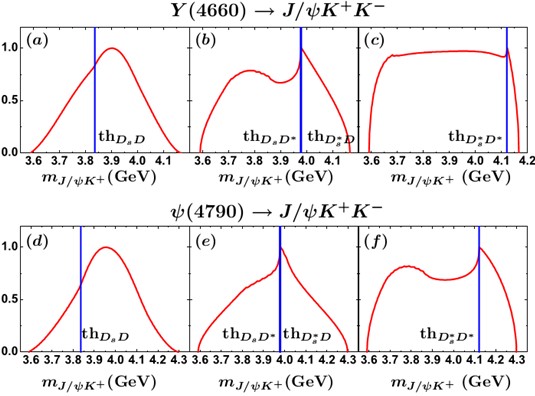
It is exciting to notice that the BESIII Collaboration has, for the first time, reported the observation of a charged charmoniumlike structure Zc(3900) in e+e-→ J/ψπ+π- at ![]() =4260MeV. As an enhancement structure around 3.9 GeV with statistical significance 9 .0σ, Zc(3900) exists in the J= J/ψKπ± invariant mass spectrum, which was the early observation.
=4260MeV. As an enhancement structure around 3.9 GeV with statistical significance 9 .0σ, Zc(3900) exists in the J= J/ψKπ± invariant mass spectrum, which was the early observation.
Rencently, charged charmoniumlike structures with hidden-charm and open-strange channels were predicted by researchers in Institute of Modern Physics, Chinese Academy of Sciences (IMP).
The initial single pion emission (ISPE) mechanism, as a new mechanism, was firstly proposed to interpret the structures Zb(10610) and Zb(10650) reported by Belle Collaboration in 2011. And then this mechanism was extended to study the dipion hidden-charm decay of higher charmonia. Enhancement structures had been predicted near the threshold of D*D and D*D* thresholds. Such structure had been discovered by BESIII Collaboration and confirmed very quickly by Belle and CLEO Collaboration.
Rsearchers further extended ISPE mechanism to initial single chiral particle emission (ISChE) mechanism to investigate the dikaon hidden-charm decay of Y(4660) and ψ(4790). Some structures near the DsD̅ */D̅ s*D and D̅ s*D* thresholds predicted in J/ψK invariant mass spectrum. These structures could be accessible for Belle and BABAR and forthcoming BelleII and SuperB Collaborations. In addition, these experimental measurements may also provide crucial test to ISChE mechanism.
The related article has been published in Phys. Rev. Lett. 110, 232001 (2013).

The invariant mass spectrum of J/ψK+ of Y(4660)/ψ(4790)→J/ψK+K‑ with the ISChE mechanism (Image by IMP)

86-10-68597521 (day)
86-10-68597289 (night)

52 Sanlihe Rd., Xicheng District,
Beijing, China (100864)

